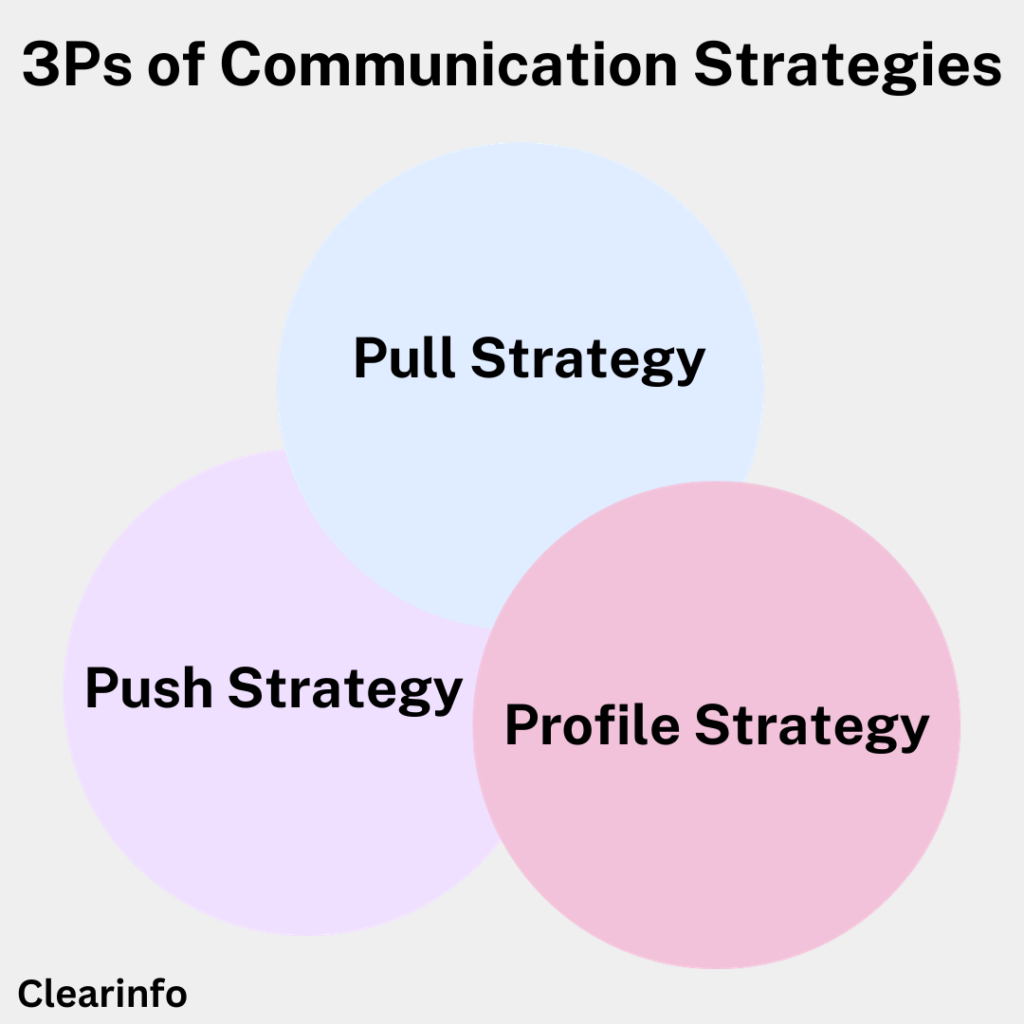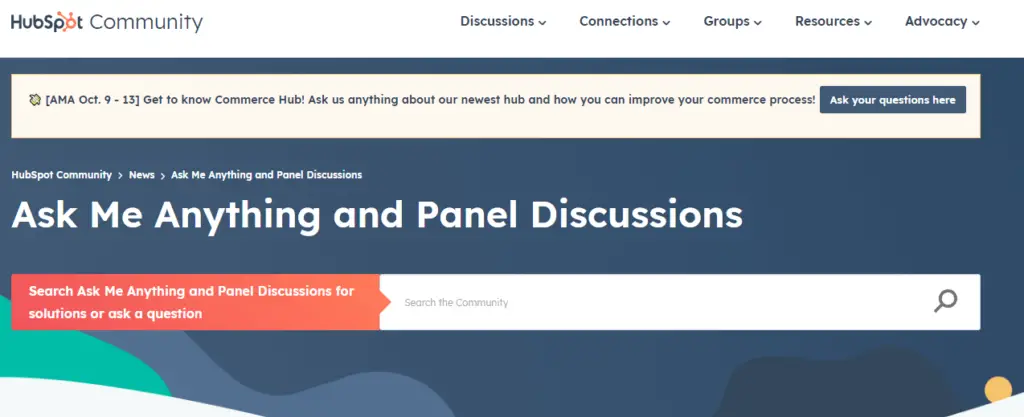In this comprehensive guide, we’ll explore 25 effective communication strategies that can transform your workplace, and keep your teams not only informed but also inspired. Whether you’re looking to develop a culture of openness during times of change or simply want to enhance everyday collaboration, these strategies are your roadmap to success.
What are effective communication strategies?
Effective communication strategies refer to approaches employed to ensure that information is conveyed, received, and understood accurately among all organizational stakeholders. These strategies aim to facilitate clear and transparent communication, develop a positive workplace culture, and support the achievement of organizational goals.
3Ps of communication strategies
The 3Ps of communication strategies — Push, Pull, and Profile — are essential concepts used in marketing and communication to engage with target audiences effectively.

These strategies help organizations tailor their messages and content to reach specific groups of people in various ways.
1. Push Strategy: Proactively send messages to the audience, often one-way and controlled by the sender (e.g., newsletters, press releases).
2. Pull Strategy: Create valuable content that attracts the audience’s engagement, typically involving two-way conversations (e.g., blogs, social media).
3. Profile Strategy: Focus on building a positive reputation, trust, and credibility, often through public relations, networking, and trust-building efforts.
Why are communication strategies important?
Effective communication strategies in the workplace are crucial for various reasons:
- Team Collaboration: Clear communication fosters collaboration among team members, leading to efficient task execution and problem-solving.
- Customer Satisfaction: Precise communication guarantees a comprehensive understanding of customer needs and concerns, leading to better customer service and satisfaction.
- Adaptability: In rapidly changing work environments, effective communication lets employees stay informed about changes, helping them adapt more easily.
- Increased Productivity: When instructions, expectations, and objectives are conveyed with precision, employees can work more productively, minimizing mistakes and rework. In fact, as per the Brosix Workplace Communication Statistics, employees who are better informed demonstrate a 77% higher level of work productivity compared to those with less information
10 Effective communication strategies for the workplace
As discussed above effective communication strategies are crucial in the workplace to enhance productivity, and maintain a positive work environment. Here are some key strategies to use for effective workplace communication:
1/ Ensure Active listening:
Active listening is a fundamental and powerful communication strategy essential for developing meaningful connections and resolving conflicts in the workplace. This includes actively participating in the conversation, understanding the speaker’s message, and responding considerately.
In active listening, employees concentrate not just on the spoken words but also on the speaker’s tone and body language. This comprehensive approach allows them to gain a better understanding of the message being conveyed.
This strategy is crucial in various workplace scenarios, from one-on-one conversations to team meetings and negotiations. Through active listening, employees can identify underlying concerns and build trust among colleagues.
2/ Encourage Questions within the workplace:
Encouraging questions promotes a culture of curiosity, active engagement, and continuous learning. Developing a workplace atmosphere where employees feel free to inquire and offer constructive challenges to ideas enables organizations to improve communication and overall productivity significantly.
When employees are encouraged to ask questions, it signifies that their input is valued. This strategy creates an atmosphere of openness, where individuals feel empowered to express their thoughts and concerns without fear of judgment. It also demonstrates that the organization values critical thinking and is open to diverse perspectives.

Check out this example of HubSpot hosting “Ask Me Anything” (AMA) sessions where employees can ask questions to company leaders. These sessions are typically hosted by different leaders each time, promoting open dialogue.
3/ Constructive Feedback:
Constructive feedback in the workplace focuses on providing feedback in a manner that is specific, actionable, and aimed at helping individuals improve their performance and skills. Unlike criticism, which often highlights faults without offering solutions, constructive feedback is designed to be supportive and encouraging, fostering a positive learning environment.
One of the key aspects of a constructive feedback system in communication is its timeliness. Providing feedback promptly after an event or situation allows employees to connect their actions with the feedback, making it more relevant and actionable.
Furthermore, feedback needs to be detailed and straightforward, addressing specific behaviors, actions, or results. Vague feedback can lead to confusion and hamper the employee’s ability to make necessary improvements.
Related Fact: Seventy-five percent of employees who receive feedback consider it highly significant for their work.
4/ Conflict Resolution Skills:
Conflict resolution skills are essential in the workplace, where diverse personalities, opinions, and working styles often collide. This communication strategy involves the ability to address and resolve disagreements or disputes among team members in a constructive manner.
Effective conflict resolution begins with open communication. Encouraging parties involved to express their concerns, perspectives, and emotions helps in understanding the root causes of the conflict. Active listening also plays a pivotal role here, enabling each party to feel heard and valued, which can defuse tension and promote mutual understanding.
However, clear communication is key throughout the resolution process. Ensuring that all parties understand the agreed-upon solutions and responsibilities helps in preventing future misunderstandings.
5/ Use of Digital Communication Tools:
Effective use of technology in communication means leveraging various platforms, such as email, video conferencing, and social media, to facilitate seamless information exchange. Companies utilizing efficient internal communication tools are 3.5 times more likely to achieve improved outcomes.
These tools break down physical barriers, allowing employees to collaborate in real time, regardless of their geographical location.
One significant advantage of technology is its ability to improve efficiency. Emails and instant messaging allow for quick circulation of information, reducing the time it takes to convey messages compared to traditional methods.
Additionally, technology enhances accessibility and flexibility in the workplace. Mobile devices and cloud-based applications enable employees to work from anywhere, breaking the traditional 9-to-5 work model.
Related Reading: Communication tools for businesses
6/ Use Storytelling While Communicating:
Storytelling is a compelling and effective communication strategy in the workplace that utilizes the power of narrative to convey messages and engage audiences. Instead of relying solely on data or facts, storytelling combines information into memorable narratives that capture the minds of employees.
In the workplace, storytelling serves various purposes. It can be used to convey the organization’s mission and values, share success stories, communicate change initiatives, or inspire teams to achieve goals.
Additionally, storytelling is an effective means of conveying complex ideas and lessons. By framing information within a narrative structure, even technical concepts can be simplified and made more accessible to diverse audiences.
This is particularly valuable in training sessions, presentations, or when introducing new policies or procedures, where understanding of information is crucial.
7/ Praise in Public, Criticize in Private:
Praise in Public, Criticize in Private, is a fundamental principles in workplace communication and management.
Public praise serves multiple purposes within an organization. When employees are acknowledged in front of their peers, it boosts morale, enhances motivation, and reinforces positive behavior. Public recognition not only validates the individual’s efforts but also sets an example for others, encouraging them to contribute meaningfully.
On the other hand, addressing criticism or constructive feedback privately is equally essential. Doing so in a one-on-one setting respects the individual’s dignity and avoids potential embarrassment. Private discussions provide a safe space for employees to receive feedback, ask questions, and discuss concerns openly.
8/ Clarity and Conciseness:
Clear and Concise Messaging emphasizes the importance of delivering information in a straightforward and easily understandable manner. This strategy revolves around the idea that effective communication minimizes misunderstandings and ensures that messages are received as intended.
In practice, clear and concise messaging involves using language that is simple, direct, and without unnecessary complexity. It aims to present information in a way that the intended audience can easily understand.
This is particularly crucial in a professional setting, where employees may come from diverse backgrounds and possess varying levels of expertise.
What are effective communication strategies for an online workplace?
1/ Regular Virtual Meetings:

In an online workplace, where face-to-face interactions are limited or non-existent, virtual meetings become the primary forum for connecting with colleagues, discussing projects, and sharing important updates. These meetings can take various forms, such as video conferences, webinars, or even audio calls, depending on the nature of the discussion and the team’s preferences.
One key benefit of regular virtual meetings is the opportunity they provide for real-time, interactive communication. Team members can see each other, hear each other’s voices, and engage in discussions, which helps build trust among remote colleagues. These meetings go beyond text-based communication, allowing for variations of body language and facial expressions to convey meaning and emotions.
2/ Conduct Online Training and Workshops:
In an online workplace, the strategy of conducting “Online Training and Workshops” is essential for continuous learning, skill development, and knowledge sharing among employees.
Online training and workshops offer a flexible and accessible way to educate employees. Whether it’s onboarding new team members, upgrading skills, or introducing employees to new tools and technologies. Virtual training modules allow individuals to learn at their own pace, fostering a culture of self-improvement and development.
Furthermore, online workshops create an interactive environment where employees can engage in discussions, ask questions, and collaborate on projects in real-time.
3/ Regular Status Updates
Regular Status Updates” are a fundamental remote communication strategy that ensures accountability and collaboration among team members.
These updates serve as a mechanism for keeping team members informed about project progress, milestones, and potential issues. In a virtual environment where face-to-face interactions are limited, these updates play a vital role in maintaining transparency, accountability, and collaboration.
These updates can take various forms, such as written reports, email updates, or brief video conferences, depending on the nature of the work and the team’s preferences. Regardless of the format, the goal is to ensure that all team members are aware of what’s happening, what’s been accomplished, and what challenges may need attention.
4/ Utilizing Instant Messaging:
Instant Messaging involves real-time text-based communication through platforms designed for quick and efficient exchanges of messages.
In today’s digital era, instant messaging has become a central tool for remote workplaces, enabling rapid interactions among team members regardless of their physical locations.
One of the primary advantages of instant messaging is its immediacy. Team members can send and receive messages instantly, facilitating quick decision-making and collaboration. This real-time communication is particularly useful for addressing urgent matters, seeking clarifications, or coordinating tasks efficiently.
Additionally, instant messaging promotes accessibility and convenience. Unlike email, which may not be checked regularly, instant messaging platforms often provide notifications, ensuring that messages are noticed promptly. This accessibility allows employees to stay connected and responsive, enhancing overall team communication.
Related Stats: Regarding the workplace adoption of commercial messaging platforms and video calling, the Pew Research Center survey indicates that 57% of respondents prefer using instant messaging services. (Source)
5/ Clear Email Communication:
Clear Email Communication is a crucial strategy in online workplaces. Effective email communication relies on concise and professional messages. Start with a clear subject line and use straightforward language. Highlight important points and use proper formatting. Manage email etiquette by avoiding unnecessary emails and being responsive. Clarity and professionalism in emails enhance overall communication efficiency.
Related Reading: Importance of email in business communication
Effective communication strategies for new business
1/ Open and Transparent Communication Channels:
Open and Transparent Communication Channels are a critical strategy for new businesses that emphasize the importance of creating an organizational culture built on trust, honesty, and accessibility. In this approach, the business establishes and maintains clear and easily accessible channels for communication at all levels, ensuring that information flows freely and that employees feel empowered to, share ideas, and express concerns.
2/ Effective Onboarding Programs:
Effective onboarding programs involve comprehensive training and orientation processes for new employees to ensure they understand the company’s communication norms. These programs play a crucial role in integrating new hires into the organization, providing them with the necessary information and tools to become productive team members.
Onboarding programs also emphasize clear communication of job roles, responsibilities, and expectations. By setting clear expectations from the beginning, new employees can quickly adapt to their roles. Clarity in communication at this stage helps prevent misunderstandings and dissatisfaction later on.
3/ Cross-Departmental Collaboration:
Cross-departmental collaboration is a strategic approach that encourages different teams and departments within a new business to work together seamlessly. By breaking down silos and promoting open communication, this strategy enhances efficiency in completing tasks. Based on a report, teams engaging in cross-functional collaboration have a 50% higher likelihood of successfully completing tasks.
In new businesses, where flexibility and adaptability are crucial, cross-departmental collaboration ensures that diverse skills and expertise are utilized to their fullest extent. When teams collaborate across functions, ideas flow freely, leading to creative solutions and a holistic approach to business challenges.
4/ Use of Visual Communication:
The use of visual communication is a highly effective strategy for new businesses looking to engage their audience and enhance understanding. Visual communication involves the use of videos, infographics, and other visual elements to convey messages, ideas, and data.
Often, startups and new businesses deal with complex concepts or data that may be challenging to convey through text alone. Visual aids help in breaking down this information, making it more accessible to a wide range of audiences, including employees, investors, and customers.
Effective communication strategies for better project management
1/ Clear Project Objectives:
Clear project objectives serve as the foundation upon which the entire project is built, providing a roadmap for success. When project objectives are clearly defined and communicated to all team members, it ensures alignment and understanding of the project’s purpose, scope, and desired outcomes.
Clear project objectives answer the critical questions of “What,” “Why,” and “How.” They specify the project’s goals and the methods to achieve those goals. This clarity eliminates ambiguity and sets expectations from the outset, reducing the risk of misinterpretations.
2/ Documented Communication:
When communication is documented, it becomes a tangible record that can be referred back to, preventing disputes. Key decisions and project milestones are captured, ensuring that there is clarity regarding responsibilities and expectations. This documentation acts as a reference guide, allowing team members to recall specific details, thereby promoting accountability and preventing crucial information from being lost.
3/ Feedback Mechanism:
In the context of project management, a feedback mechanism refers to a structured process through which team members, stakeholders, and clients can provide input and express opinions regarding various aspects of the project.
Feedback mechanisms provide a channel for team members to express their thoughts about the project’s progress, share challenges they might be facing, and suggest potential solutions. This input is invaluable for project managers as it offers insights into the areas that require additional support or resources.
4/ Communication Protocols and Guidelines:
Communication protocols and guidelines are essential frameworks that establish the rules and expectations for how communication occurs within a project. In the context of project management, these protocols serve as a roadmap, ensuring that information flows efficiently, accurately, and in a manner that supports the project’s goals.
Communication protocols also define the preferred methods of communication, specifying whether certain messages are best conveyed through emails, phone calls, or virtual meetings. This clear communication ensures that messages are received and understood as intended.
Effective internal communication strategies to use during organizational change
1/ Clear and Timely Updates from Leadership:
During times of organizational change, “Clear and Timely Updates from Leadership” is a critical internal communication strategy. It involves consistent and transparent communication from top-level management to employees to keep them informed about the changes, the reasons behind them, and the expected impact on the organization.
Clear and timely updates from leadership create a sense of trust and stability within the organization. When leaders honestly discuss changes, employees are better able to understand the reasons behind them.
2/ Open Q&A Sessions and Town Hall Meetings:
Open Q&A sessions and town hall meetings are employed during times of organizational change. These interactive forums serve as platforms where employees can engage directly with leadership and gain insights into the changes occurring within the organization.
By facilitating open Q&A sessions, organizations create an atmosphere of transparency and openness. This direct communication helps eliminate rumors and relieve anxieties associated with change. It builds trust between employees and leadership, fostering a sense of confidence in the decision-making process.
3/ Internal Communication Platforms and Forums:
Internal communication platforms and forums are essential tools during organizational change. These digital platforms and spaces provide a structured environment for employees to access information, share insights, and stay connected throughout the transition. These platforms serve as central hubs for distributing change-related information.
Leaders can post updates, announcements, and documentation related to the changes, ensuring that employees have easy access to the latest information. This accessibility minimizes confusion and keeps everyone on the same page regarding the change process.
4/ Detailed Change Documentation and FAQs:
Detailed change documentation and FAQs are crucial during organizational change. These resources provide clear, comprehensive information about the changes, helping employees understand the reasons, scope, and impact. By addressing common questions, they reduce uncertainty. Detailed documentation empowers employees to adapt effectively and helps managers support their teams. Continuously updating these resources ensures employees have the most accurate and relevant guidance.
Examples of effective communication strategies in an organization
Example 1.1
Employee Feedback Surveys: Companies regularly conduct anonymous surveys to gather feedback from employees. The insights gained help in identifying issues, understanding concerns, and making data-driven decisions to improve workplace conditions and job satisfaction.
Example 2.1
Internal Social Media Platforms: Many organizations use internal social media platforms, similar to Facebook or Slack, to facilitate communication. Employees can create groups, share updates, and engage in discussions, enabling real-time information exchange and collaboration.
Related Reading: What is effective communication examples
How do you create a successful communication strategy?
Creating a successful communication strategy requires a thoughtful and systematic approach. Here are the key steps to develop an effective communication strategy:
1/ Understand Your Audience: Start by identifying your target audience. Comprehend their demographic information and communication habits, and customize your message to resonate with them effectively.
2/ Define Clear Objectives: Determine what you want to achieve with your communication efforts. Whether it’s increasing employee engagement, improving customer satisfaction, promoting a new product, or utilizing employee engagement platforms, having clear objectives provides direction.
3/ Craft a Compelling Message: Create a message that is clear, brief, and persuasive, ensuring it aligns seamlessly with your objectives. Ensure it’s easy to understand and resonates emotionally with your audience.
4/ Choose Appropriate Channels: Select the right communication channels based on your audience. This could include email, social media, in-person meetings, or a combination of these.
5/ Engage in Two-Way Communication: Encourage feedback and active participation. Pay attention to the concerns, questions, and suggestions of your audience.
6/ Evaluate and Adapt: Regularly assess the effectiveness of your communication efforts. Use feedback, surveys, and analytics to measure the impact. Be willing to adapt your strategy based on what works best.
By following these steps and remaining adaptable, organizations can create communication strategies that are not only successful but also responsive to the changing needs and expectations of their audience.
How can effective communication strategies be implemented at all levels of an organization?
Implementing effective communication strategies at all levels of an organization requires a holistic and inclusive approach. Here are the key steps to ensure communication strategies are successfully integrated throughout the organization:
1/ Leadership Commitment: Start with a strong leadership commitment to open communication.
2/ Clear Policies: Establish clear communication policies emphasizing honesty and respect.
3/ Training: Provide communication training for all employees.
4/ Regular Meetings: Hold meetings and departmental gatherings for updates and discussions.
5/ Feedback Channels: Encourage feedback through various channels like surveys and suggestion boxes.
6/ Technology Use: Utilize internal communication platforms and collaborative tools.
7/ Cross-Functional Teams: Foster collaboration with diverse, cross-functional teams.
8/ Clear Channels: Establish clear communication channels for important information.
9/ Recognition: Acknowledge and appreciate employees publicly for their contributions.
10/ Lead by Example: Leaders should demonstrate proficient communication practices.
11/ Feedback Loops: Establish consistent feedback mechanisms to assess and adapt communication strategies.
How can effective communication strategies enhance collaboration and coordination among team members?
Effective communication strategies play a pivotal role in enhancing collaboration and coordination among team members. When team members communicate clearly and openly, it fosters a sense of unity, trust, and shared purpose within the team. Here’s how effective communication achieves this:
1/ Clear Understanding of Goals: Effective communication ensures that all team members have a clear understanding of project goals, objectives, and priorities. When everyone is on the same page, it becomes easier to work towards a common purpose.
2/ Role Clarity: Communication strategies help clarify team members’ roles and responsibilities. When everyone knows their specific contributions and understands their colleagues’ roles, it minimizes duplication of efforts and maximizes efficiency.
3/ Consistency: Consistent communication practices ensure that messages and expectations are clear and predictable. This reduces misunderstandings and creates a stable foundation for collaboration.
4/ Feedback Loops: Effective communication involves regular feedback loops. Team members can provide input on each other’s work, allowing for improvements and adjustments.
5/ Knowledge Sharing: Effective communication promotes knowledge sharing. Team members can share best practices, lessons learned, and relevant information, leading to continuous learning and improvement within the team.
Related Reading: Techniques for effective communication in the workplace
Frequently Asked Questions
Q1) What strategies can you use to communicate effectively in the workplace?
Ans: There are several effective strategies for workplace communication:
- Active Listening: Give your full attention to understanding the speaker’s message before you start shaping your response.
- Use of Technology: Utilize email, messaging apps, and collaborative platforms for efficient communication.
- Empathy: Understand and consider the emotions of your colleagues to build rapport.
- Constructive Feedback: Offer feedback that is detailed, constructive, and motivating.
- Non-Verbal Communication: Be mindful of body language and facial expressions to fully grasp the entire message.
- Respect Diverse Perspectives: Acknowledge and appreciate different viewpoints, promoting inclusivity.
- Team-building Activities: Engage in team-building exercises to improve interpersonal relationships and communication skills.
Q2) What are the 4 types of communication strategies?
Ans: The four types of communication strategies are:
- Verbal Communication: Involves spoken words, facilitating real-time interaction in conversations or meetings.
- Nonverbal Communication: Includes body language and gestures, conveying emotions and attitudes without words.
- Written Communication: Utilizes text, such as emails and reports, for precise and structured message delivery.
- Visual Communication: Uses charts and images to simplify complex data, aiding in better understanding and retention.
To know more check out our article on: What are the 4 main types of communication?
Q3) What are the 4 principles of communication in the workplace?
Ans: Effective workplace communication centers around four key principles. Clarity ensures messages are easily understood, conciseness keeps communication focused and efficient, consistency prevents confusion by maintaining uniform information, and courtesy fosters a positive and respectful atmosphere. These principles, when applied, create a harmonious and productive workplace environment.
Q4) What is a key strategy in successful business communication?
Ans: A key strategy in successful business communication is clarity. Messages need to be clear, concise, and easily understood to ensure effective communication within the business environment.



